 |
How to strengthen memoryLatest mechanism of memory and its training
|
Cat: SCI
|
Yuji Ikegaya |
07127u/18214r |
Index
Tag
; 5% decrese in 70; 100B neurons; Acetylcholine; Action potential; Amnesia; Amygdala; ; Axion; CA1 field; Childhood amnesia;; Classification of memories; Dementia; ; Dendrite; ; Dysmobility; Effort & patience; Episodic-Semantic; Germination; Glutamic acid; Hebbian Theory; Na+ ion; Hippocampus; Ischemia; Long-Term Potentiation; Mnemonic techniques; Synapse flow; Temporal lobe; Tetrodotoxion; Three elements of memorization; ;
Why?
- Dr. Y. Ikegaya is a budding neuroscientist of brain. His theme
is to clarify the mechanism of memory, which encourage us, particularly
senior generation, to challenge to memorize and study new things.
- I'd utilize his theory to summarize and to take a note for better
remembrance, which should be called as "a hippocampus
way of mnemonics"
- 池谷裕二は新進の脳科学者である。彼のテーマは記憶のメカニズムを明らかにすることであり、それは我々、特にシニア世代が新たな事柄を記憶し学習しようとする勇気づけとなる。
- よく覚えるために、彼の理論をまとめ方やノートの取り方に利用したいと思う。名付けて「海馬的記憶術」と呼ぶ。
Key
word
キーワード
>Top 1. Memory viewed from neuroscience:
 Neuron:
Neuron:
- Source: Wikipedia ->
- 100 billion cells in our brain, with 10-50 micron
- 1000 trillion synapse
- No individual difference in in form or arrangement of
the cells.
- Number is decreasing from the birth: several ten thousand
a day, or one per one second. Averagely 5% decrease at 70 years
old.
- Neuron has no ability of breeding; probably due to maintenance
of its personality.
- During the process of long natural selection, the brain has
chosen to utilize the same neurons during its own life.
- Inhibiting decrease of neuron:
- Maximum usable neurons in life: about 10%
- >Top Encephalopathy (Brain disorder):
- Dementia: Alzheimer's disease
- Dysmobility: Parkinson's disease
- Causes:
- Blow to the head
- Excessive drinking
- Sleeping pills
- Stimulant drug
- >Top Hippocampus (HIPP):
- located backside of temporal lobe (lobus temporalis) ; a pair, 10cm length, 1cm think
- cells of hippocampus have breeding capacity.
- incentive and fertile environment
- Source: ->
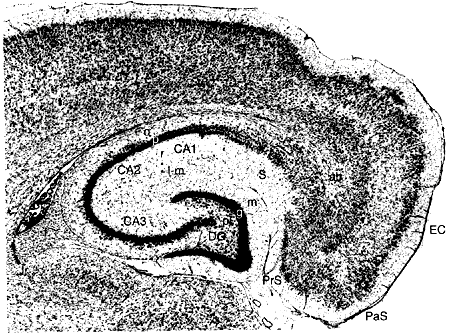
The Synaptic Organization of the
Brain, Gordon M. Shepherd, 2003
1.
脳科学から見た記憶:
- ニューロン:
- 大脳の神経細胞数: 1000億個、直径10-50μm
- シナプス数: 1000兆個
- 細胞の並び方には個人差なし
- 数は誕生以来減少し続ける。一日に数万個、1秒に1個の割合。70歳で5%減。
- 神経細胞には増殖能力なし。その理由は脳の個性を維持するためか。
- 脳は長い自然淘汰の過程で、同じ神経細胞を生涯かけて使い回す方法を選択した。
- 神経細胞減少の抑制:
- 生涯利用可能な神経細胞: 約10%
- 脳障害:
- 痴呆症(認知症): アルツハイマー病
- 運動障害: パーキンソン病
- 原因:
- 脳の強打
- 飲み過ぎ
- 睡眠薬
- 覚醒剤
- 海馬:
- 側頭葉の裏側、耳の億に一対。長さ10cm、直径1cm
- 海馬の細胞は増殖する
- 刺激のある豊かな環境
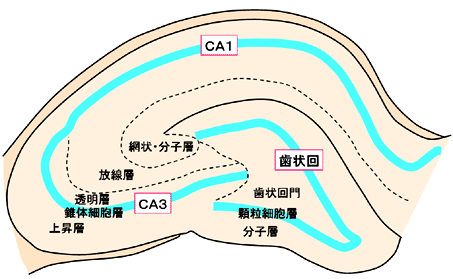
>Top 2. Control tower of memory - Hippocampus:
- Amnesia:
- anterograde amnesia: unable to remember anything after
the onset of amnesia for more than a few moments.
- retrograde amnesia: unable to recall events before the onset
of amnesia
- Observation of Hippocampus:
- Activity: by PET (Positron Emission Topography)
- Observation of living cell: by Cofocal laser scanning microscope
- 10
billion neurons in hippocampus:
- >Top Information (main synapse) flow : clockwise rotation
- Temporal lobe -> Dentate gyrus -> CA3 field -> CA1 field
- -> Subiculum promontorii -> Temporal lobe
- Though the above clockwise rotation, the information is processed,
modulated, integrated, or deleted.
- Thus, the information is foodstuff, then is processed into
cooking at hippocampus, whose neurons functions as the recipe.
- Difference among animals:
- Lower animal: has developed Dentate gyrus
- Higher animal: has developed CA1 field.
- Only granule cells of Dental gyrus can increase, also can
decrease numbers.
- Magical number seven: (A. Miller, 1956)
- Channel capacity of a number of human cognitive and perceptual
tasks: between 5 - 9
- Short-term memory: 7 plus/minus 2
- >Top Classification of memories:
Declarative (explicit)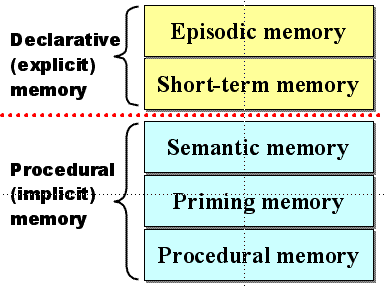 and Procedural
(implicit) memory:
and Procedural
(implicit) memory:
- Declarative memory requires conscious recall, subdivided
into:S
- Episodic memory; used for more personal memories, specific
to particular context
- Semantic memory; encoding of abstract knowledge
- Priming memory; a process of memory which was subconsciously
prepared shows easiness of memory.
- Procedural memory: depends on different brain region.
- Sensory Memory (Short-term or working memory): only 0.5 -
2 seconds, subdivide into:
- iconic memory: concerned with visual input. Persistence
in vision as the light would leave lines in the dark.
- echoic memory: concerned with auditory input
- >Top Hippocampus deeply relates to Episodic memory and Semantic
memory.
- Hippocampus screens of information to be stored at temporal
lobe which is storage of information.
- Theta wave is a kind of brain wave which is emitted from
Hippocampus.
- >Top Babies before 2-3 years has not yet developed Hippocampus,
and they cannot make Episodic memory. (Childhood amnesia)
2.
記憶の司令塔 - 海馬:
- 健忘症:
- 順行健忘: 新しいことを覚えない症状
- 逆行健忘: 昔のことを思い出せない症状
- 海馬の観察:
- PET
- 共焦点レーザー顕微鏡
- 情報の流れ: 海馬の主要3シナプス回路:
- 側頭葉→歯状回→CA3野→CA1野
- →海馬支脚→側頭葉
- 上記の時計回りの回転の間に、情報は処理・変調・統合・削除される。
- ここで情報は食材であり、海馬で料理となる。海馬の神経回路の特性というレシピがある。
- 動物による違い:
- 下等動物:歯状回が発達
- 高等動物:CA1野が発達
- 歯状回の顆粒細胞のみが増殖可能、かつ減少もする。
- マジカルナンバー7:
- 一時的に認識できる数、短.期記憶は7 ±2
- 記憶の分類:
- 1) 顕在記憶
- エピソード記憶: 個人的な記憶
- 短期記憶: 0.5 - 2秒間
- 2) 潜在記憶
- 意味記憶: 抽象的な知識
- プライミング (入れ知恵) 記憶:
- 手続き記憶:
脳の別領域に依存
- 海馬はエピソード記憶と意味記憶に深く関係した脳部位
- 海馬は情報のふるいで、情報は貯蔵庫である側頭葉に貯蔵する。
- θ波: 海馬から発する脳波
- 2-3歳前の幼児は海馬は発達していないので、エピソード記憶はできない。(幼児期健忘)
>Top 3. Brain and computer:
- Source: Wikipedia, 2007
- Synapses allow nerve
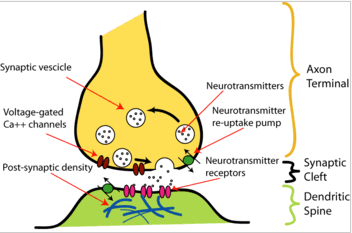 cells to communicate with one another through axons and dendrites, converting electrical impulses into chemical
signals.
cells to communicate with one another through axons and dendrites, converting electrical impulses into chemical
signals.
- A neurons (Nerve cell) is electrically excitable cell which
is composed of a cell body (soma), an axon, and several dendritic
trees.
- An axon sends information, while a dendritic tree receives
information.
- >Top Toxin of blowfish: Tetrodotoxin blocks the voltage-gated
sodium channels in nerve cell membranes.
- Communication speed: 100m per second
- >Top Neurotransmitter:
- Glutamic acid: to relay, amplify and modulated electrical
signals.
- Acetylcholine (ACh) : voluntary movement of the muscles
- Mechanism of neurotransmitter (Exocytosis)
:
When nerve impulse (action potential) comes to the synapse, the
rapid depolarization causes calcium ion channels to open. Calcium
then stimulates the transport of vesicles to the synaptic membrane;
the vesicle and cell membrane fuse, leading to the release of the
packaged neurotransmitter.
- One-way clockwise traffic:
- There will no adverse current in this
mechanism, unlike electric circuit.
- Distance of synaptic cleft: about 20 nm
- Length of axons (pre-synaptic nerve terminal): sometimes
more than 100cm
- Length of dendritic trees (post-synaptic cell): around 1cm
- >Top Action potential:
- Action potential transmitted by Na+ ion: just like digital
signal
- Synaptic potential: just like analog signal
- Neuron considers whether transmit or not according to the
strength of synaptic potential.
- Spines of dendric tree changes chemical
signal to electric signal.
3.
脳とコンピュータ:
- 神経細胞は電流で刺激受ける細胞であり、細胞本体と1本の神経突起 (軸索突起)と数本の樹状突起からなる。
- 軸索突起は、情報の送り手で、樹状突起は受け手
- ふぐの毒:テトロドトシシンは、神経細胞膜にあるナトリウムが通過する電位ゲートをブロックしてしまう。
- 神経の伝達速度:秒100m
- 神経伝達物質:
- グルタミン酸: 脳内神経伝達
- アセチルコリン: 筋肉動作指令
- 神経伝達物質のメカニズム:
シナプスに活動電位が伝えられると、分極が起こりカルシウムイオンチャネルが開く。カルシウムはシナプス小胞をシナプス膜に向かって刺激する。小胞と細胞膜とは反応して小胞内の神経伝達物質を放出する。
- 時計回りの一方通行:
これらの信号は逆流しない。
- シナプス間隙:約20 nm
- 軸索 (シナプス前側)の長さ:100cm以上
- 樹状突起 (シナプス後側)の長さ:1cm程度
- 活動電位:
- 活動電位:
デジタル的、Naイオンによる。
- シナプス電位:
アナログ的
- 神経細胞はシナプル活動の強弱によって伝達するかどうか思考する。
- 樹状突起のスパインは化学信号を電気信号に変える。
>Top 4. Synaptic Plasticity:
- Operant conditioning: Memory is build by efforts and patience.
- higher animals can make more fuzzy memory, while lower animals
tend to lose their lives due to rigid memory, never to learn by
failures.
- It is not a good brain which has unforgettable memory
forever.
- >Top Three elements of memorization:
- Remember by many failures.
- Remember according to due procedures.
- Remember by clear difference.
- Essence of memory:
Memory is a change of neural circuit, or making a new pattern of
neuronal circuit. There are three ways to form a new neural circuit:
- >Top Growth of a new neuron
- Development of a new synapse (germination).
- Increase of transmission efficiency of synapses.
- The above 1. and 2. take from several minutes
to several days.
- The above 3. is a change of resistance, changing plasticity
of synapse.
- >Top Hebbian Theory: (Donald Hebb, 1949)
- Combined effort : Synapse can transmit strong stimulus over
the threshold:
- Singularity: Synaptic plasticity occurs at the confined
targeted synapse.
- Association: Activity in one facilitates activity in the
other. Euphony.
4. シナプス可塑性:
- オペラント条件づけ: 記憶は努力と根気
- 高等動物ほどファジーな記憶ができ、一方、下等動物は厳格な記憶のせいで命を落とすことが多い。失敗から学ぶことをしないので。
- つまりいつまでも忘れない脳は優れていない
- 記憶の3カ条:
- 失敗を繰り返して覚えるべし
- 手続きを踏んで覚えるべし
- 明らかな違いによって覚えるべし
- 記憶の本質:
神経回路の変化、あるいは新たな神経回路のパターンを作ることである。新たな神経回路を形成するためには3つの方法がある。
- 新たな神経回路の増殖
- 新たなシナプスの発生 (発芽)
- シナプスの伝達効率の上昇
- 上記1と2は数分から数日かかる。
- 上記3は、シナプスの抵抗、即ち可塑性が変化する。
- ヘブの法則:
- 協力性: シナプスは閾値を超えた強い信号だけを記憶する。
- 入力特異性: シナプス可塑性は起こるべきシナプスに限定して生じる。
- 連合性: 事象を連合させると覚えやすくなる。語呂合わせなど。
>Top 5. Long-Term Potentiation
(LTP):
- Source: Wikipedia↓
- An example of LTP recorded at Schaffer collateral/CA1 synapses
in the hippocampus of rat brain. PTP = Post-Tetanic Potentiation.
Note how the amplitude of the EPSP field settles into a new, more
elevated level after tetanic stimulation.
- >Top LTP (Long-Term Potentiation) is an increase in the chemical strength of a synapse that
lasts from minutes to several days. It has been observed both
in living animals (in vivo) and in cultured cells (in vitro).
- LTP is believed to contribute to synaptic plasticity in living
animals, causing memory formation, and its opposing process, Long-Term
Depression (LTD) causing forgetfulness formation.
- Tetnus causes most effectively LTP with theta rhythm.
- When LTP occurs, velocity of neurotransmission increases from
63 ms to 45 in arriving to CA1 field.
- AMPA receptor:
mediates fast synaptic transmission, activated
by glutamate.
- NMDA receptor: only activates by lots of glutamate. In addition,
NMDA can pass calcium ion, which resultingly increases the number
of AMPA receptors from the reserve.
- >Top Amygdala: (about 1cm in diameter) performs a primary role in
the formation and storage of memories associated with emotional
events. Greater emotional arousal following a learning event enhances
retention of that event.
5.
脳のメモリー素子 (LTP):
- 出典:Wikipedia
- ネズミの脳の絵画でのCAシナプスでのLTP変化の例。PTP=Post-Tetanic Potentialtion Tetanus
(Tetanusとは高周波の電気刺激)による刺激の前後でのシナプス電位の違いに注目
- LTP (長期増強)はシナプスにおける化学的強さの増加であり、数分から数日間継続する。これは生体および実験で確認されている。
- LTPは、動物におけるシナプス可塑性に関与しており、記憶を形成したり、またはその逆のプロセスである、長期の抑圧によって忘却を生じたりする。
- テタヌスはθリズムで与えると最も効率的にLTPを生じる。
- AMPA受容体:
グルタミン酸によって刺激を受けて、感度よくシナプス伝送を仲介する。
- NMDA受容体:グルタミンが多い場合のみ活性化。またこのNMDAはカルシウムイオンを通し、それによって予備に置いてあるAMPA受容体の数を増加させる。
- 扁桃体: (直径約1cm) 感情に関連した記憶の形成と保管に主要な役割がある。各週に関連して情動が大きくなるとそれに関する記憶保持が高められる。
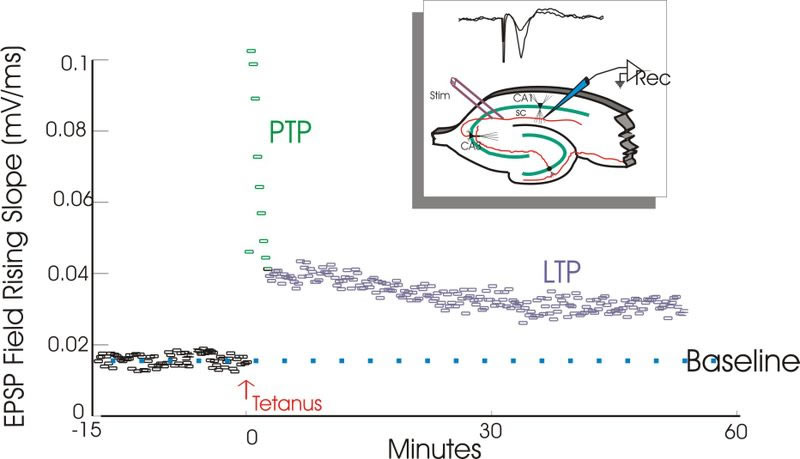
>Top 6. Medicine for
memory fortifier:
- Hermann Ebinghaus discovered the exponential nature of forgetting:
R = e^(-t/S), R is memory retension, S is strengh of memory, t
is time.
- >Top Best methods for increasing the strengh of memory are:
- better memory representation (mnemonic techniques)
- repetition based on active recall (spaced repetition)
- say, review after a week, then after two weeks, and
then after a month.
- Mystery of dream:
- REM (Rapid Eye Movement) sleep: body is sleeping, brain is
not. Having a dream occurrs during REM sleep state.
- non-REM sleep: brain is sleeping, body is not.
- Dream is a kind of recall of memory.
- Professional go/shogi players memorization method:
- Combination of Episodic memory and Procedual memory:
- Professional shogi players can reproduce all processes
of record of their games.
- They recall the record by their own Episodic memory as
well as nomothetic patterns by Procedual memory.
6. 記憶力増強薬:
- Hermann Ebinghausは忘却曲線を発見:
R = e^(-t/S) ここでRは記憶保持量、Sは記憶の強さ、tは時間
- 記憶を増強する最善の方法は、
- 想像力を発揮して記憶する
- 時間を置いて積極的に復習
- 1週間後、2週間後、1ヶ月後など
- 夢の不思議:
- レム睡眠:身体は寝ていて、脳は寝ていない。夢を見るのはレム睡眠の間。
- ノンレム睡眠: 脳は寝ていて、身体は寝ていない。
- 夢は一種の記憶の再生
- 天才棋士の記憶術:
- エピソード記憶と手続き記憶の組合せ
- プロ棋士は自分のゲームの全棋譜を再現できる。
- 彼らは自身のエピソード記憶と同時に手続き記憶による法則性によって棋譜を再現している。
>Top 7. Future of neuroscience:
- Subjects of future neuroscience:
- Doping of intellectual powers.
- Medical treatment of dementia.
- Brain transplant.
- 3 stage of memory:
- 1) Learning mechanism,
- 2) Storage of memory,
- 3) Recall of
memory
- Within above recalling process is still unknown area.
- Episodic memory is much easier to recall than semantic
memory.
- >Top Features of hippocampus:
- High grade function as well as easier affection of disease
and weakness by ischemia.
7. 脳科学の未来:
- 将来の脳科学の課題:
- 知能のドーピング
- 痴呆症の治療
- 脳移植
- 機能の3段階
- 1) 学習すること、
- 2) 記憶すること、
- 3) 思い出すこと
- この内、再生のプロセスが未知の分野
- エピソード記憶の方が意味記憶より遙かに思い出しやすい。
- 海馬の特徴:
- 高機能、同時に疾患にかかりやすく、虚血に弱い
Comment
- I have thought until now sleeping is a kind of rest of body.
But it is not true. This book shows that sleep is important for
a job; keeping memories in order, throwing
away useless ones, and consolidating useful ones.
- So, it would be correct to say that let's sleep to arrange memories
and make more free memory space for tomorrow's valuable life.
- 睡眠は身体を休めるためのものと今まで思ってきた。それは正しくない。本書によれば、睡眠は仕事にとっても重要である。記憶を整理し、無用なものを捨て、有用なものを集約するのである。
- つまり、記憶を整理して明日の価値ある生活のためのメモリー空間を空けるために寝ようと言うのが正しいということになろう。
Index |
||
|---|---|---|
Tag |
; 5% decrese in 70; 100B neurons; Acetylcholine; Action potential; Amnesia; Amygdala; ; Axion; CA1 field; Childhood amnesia;; Classification of memories; Dementia; ; Dendrite; ; Dysmobility; Effort & patience; Episodic-Semantic; Germination; Glutamic acid; Hebbian Theory; Na+ ion; Hippocampus; Ischemia; Long-Term Potentiation; Mnemonic techniques; Synapse flow; Temporal lobe; Tetrodotoxion; Three elements of memorization; ; | |
Why? |
|
|
Key word |
キーワード |
>Top 1. Memory viewed from neuroscience:
|
1. 脳科学から見た記憶:
|
>Top 2. Control tower of memory - Hippocampus:
|
2. 記憶の司令塔 - 海馬:
|
>Top 3. Brain and computer:
|
3. 脳とコンピュータ:
|
>Top 4. Synaptic Plasticity:
|
4. シナプス可塑性:
|
>Top 5. Long-Term Potentiation (LTP):
|
5. 脳のメモリー素子 (LTP):
|
 |
|
>Top 6. Medicine for memory fortifier:
|
6. 記憶力増強薬:
|
>Top 7. Future of neuroscience:
|
7. 脳科学の未来:
|
Comment |
|
|